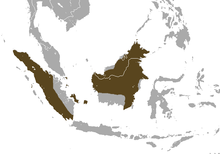
The treeshrews are small mammals native to the tropical forests of South and Southeast Asia. They make up the entire order Scandentia, which split into two families: the Tupaiidae, and the Ptilocercidae.

The Indomalayan realm is one of the eight biogeographic realms. It extends across most of South and Southeast Asia and into the southern parts of East Asia.

The Madras treeshrew, also known as the Indian treeshrew, is a species of treeshrew in the monotypic genus Anathana found in the hill forests of central and southern India. The genus name is derived from the Tamil name of moongil anathaan and the species name is after Sir Walter Elliot of the Indian Civil Services in Madras.

Nepenthes macrophylla, the large-leaved pitcher-plant, is a tropical pitcher plant known only from a very restrictive elevation on Mount Trusmadi in Sabah, Malaysian Borneo.
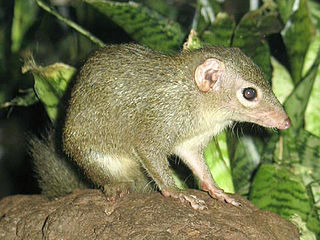
The common treeshrew is a small mammal in the treeshrew family Tupaiidae, and is native to Thailand, Malaysia, and Indonesia. It has been listed as Least Concern by IUCN as it remains common and displays some adaptability to ongoing habitat loss.

The Sunda clouded leopard is a medium-sized wild cat native to Borneo and Sumatra. It is listed as Vulnerable on the IUCN Red List since 2015, as the total effective population probably consists of fewer than 10,000 mature individuals, with a decreasing population trend. On both Sunda Islands, it is threatened by deforestation. It was classified as a separate species, distinct from the clouded leopard in mainland Southeast Asia based on a study in 2006. Its fur is darker with a smaller cloud pattern.
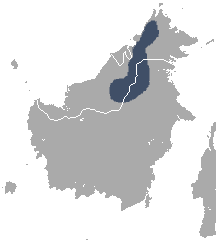
The Bornean smooth-tailed treeshrew is a species of treeshrew in the family Tupaiidae. It is endemic to Borneo. Its natural habitat is subtropical or tropical dry forests. It is threatened by habitat loss.

The pen-tailed treeshrew is a treeshrew of the family Ptilocercidae native to southern Thailand, the Malay Peninsula, Borneo, and some Indonesian islands.

The slender treeshrew is a treeshrew species within the Tupaiidae. It is native to Borneo and inhabits foremost lowland old forest.
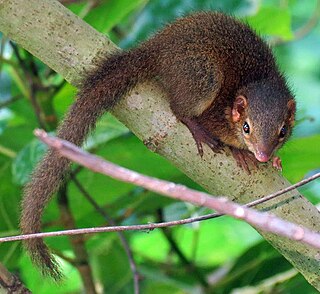
Horsfield's treeshrew, also called Javan treeshrew, is a treeshrew species within the Tupaiidae. It is endemic to the Indonesian islands of Sumatra, Bali, Java and Nias where it inhabits foremost primary forest.
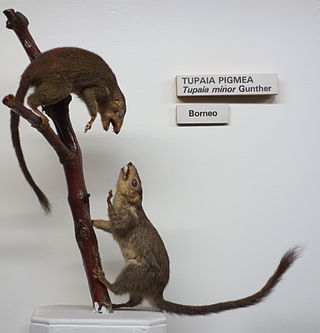
The pygmy treeshrew is a treeshrew species within the family Tupaiidae. It is native to Thailand, Malaysia and Indonesia. The generic name is derived from the Malay word tupai meaning squirrel or small animals that resemble squirrels.

The mountain treeshrew is a treeshrew species within the Tupaiidae. It is endemic to Borneo and inhabits montane forests in Sarawak and Sabah, Malaysia, and Kalimantan, Indonesia.

The Mindanao treeshrew, also called the Philippine tree shrew, is a species of treeshrew endemic to the Mindanao region in the Philippines. It was formerly considered the only member of the genus Urogale, but that genus was merged into Tupaia when the species was found to nest within the latter genus in a molecular phylogeny. The scientific name commemorates British colonial administrator and zoological collector Alfred Hart Everett.

Tupaia is a treeshrew genus in the family Tupaiidae that was first described by Thomas Stamford Raffles in 1821. The name of this genus derives from the Malay word tupai meaning squirrel or small animal resembling a squirrel.

Tupaiidae is one of two families of treeshrews, the other family being Ptilocercidae. The family contains three living genera and 19 living species. The family name derives from tupai, the Malay word for treeshrew and also for squirrel which tupaiids superficially resemble. The former genus Urogale was disbanded in 2011 when the Mindanao treeshrew was moved to Tupaia based on a molecular phylogeny.
Tupaia miocenica is a fossil treeshrew from the Miocene of Thailand. Known only from a single tooth, an upper first or second molar, it is among the few known fossil treeshrews. With a length of 3.57 mm, the tooth is large for a treeshrew. At the back lingual corner, the tooth shows a small cusp, the hypocone, that is separated from the protocone in front of it by a narrow valley. The condition of the hypocone distinguishes this species from various other treeshrews. In addition, the presence of a well-developed but simple mesostyle is distinctive.

The Sunda leopard cat is a small wild cat species native to the Sundaland islands of Java, Bali, Borneo, Sumatra and the Philippines that is considered distinct from the leopard cat occurring in mainland South and Southeast Asia.

